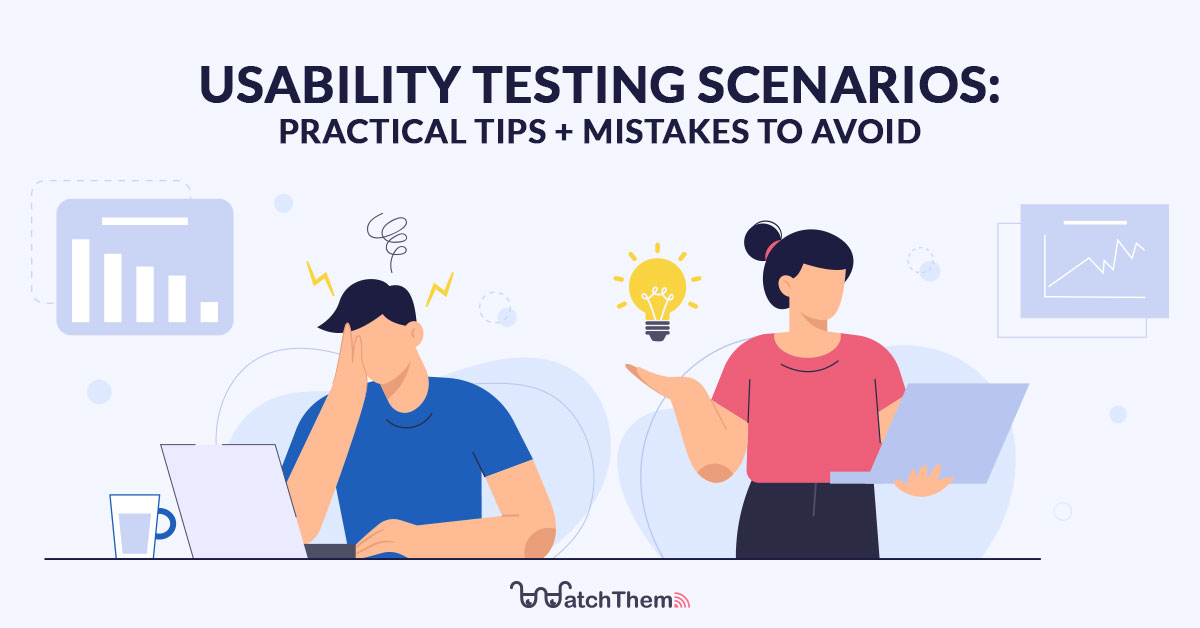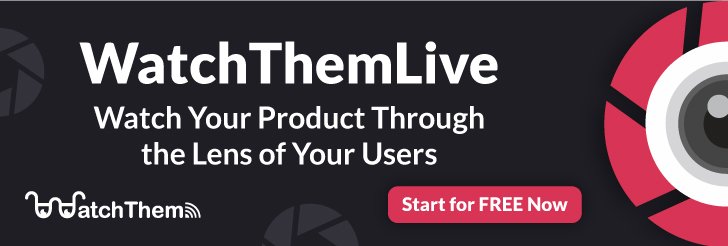Page Contents
If you’re new to this field and haven’t heard it like a thousand times, I shall inform you that usability testing is one of the most important steps of developing a product, and it cannot be skipped. Performing usability testing is a vast topic on its own, but here we’re going to discuss usability testing scenarios, what they are, and why we need to use them.
Note: WatchThemLive is a very cost-effective solution that will help you perform an efficient usability test on your website with a session recording tool and many other features. Now you have the opportunity to SIGN UP and grab a FREE package!
Now, on with the article and task scenarios!
What Are Usability Testing Scenarios (and Tasks)
To run a usability test, before thinking of usability testing scenarios, you should first come up with a list of usability testing tasks that you require the participants to complete.
For example, take a look at these tasks for testing a film database website:
- Sign up and choose “musical” and “thriller” as the categories you’re interested in.
- Find the movie Sweeney Todd: The Demon Barber of Fleet Street (2007) and mark it as a favorite.
- Look for the movie Raw (2016) and find its duration.
After you’ve decided what tasks you’re going to give your participants to complete, it’s time to think of scenarios.
Usability testing scenarios are the foundation of these tests because they accurately express what you want your participants to do during the test and make the tasks more tangible.
A well-written task scenario makes the test more realistic and allows you to focus on developing around the actual needs of users.
When you have the tasks and scenarios ready, it’s time to perform the test. As I mentioned, WatchThemLive is an extremely useful tool that will help you perform your usability test with your users and track the task completions using its session recording feature. Check out the short video below to see how WatchThemLive’s session recordings can help you in usability testing. Make sure to SIGN UP. It’s FREE!
Usability Testing Scenarios Examples
As I explained, the purpose of a usability testing scenario is to make the task sound more like something a user would do in a real situation in their daily life. For example, if you’re testing an online mobile store, a task and scenario you could come up with would look like this:
Task: Add a product to your cart.
Scenario: You’ve had your current phone for quite some time, and recently you’ve been facing various problems because of its rather old hardware and, especially, its outdated camera. You have a budget of 600$. Look for your ideal smartphone in this range and purchase it.
As you can see, the scenario we came up with gives our task fine details and makes the participants feel like they are in a real situation and need to consider various criteria while completing the task instead of going through the process superficially.
Here’s another example from the usability testing of an internet service provider company’s website:
Task: Purchase an internet service.
Scenario: You’ve decided to switch to a new internet service provider you’ve seen ads for on YouTube recently. You’re a hardcore gamer, so you need a really high-speed connection to download game data and their ridiculously frequent and heavy updates. Find a plan that suits your needs and activate it.
How Do You Write Usability Testing Scenarios? (Dos and Don’ts)
You’re now familiar with the concept of test scenarios and a couple of examples. But how do you write usability test scenarios? You need to consider various aspects when writing scenarios to lead your participants to perform true to life, giving you more reliable data as a result.
1- Use Realistic Tasks with Realistic Participants
When you ask a participant to do something they don’t regularly do, there’s a high chance that they will try to complete it without deeply interacting with the interface.
The individuals you recruit for usability testing and the aspects you assess will determine how realistic the activities are.
For example, if you’re testing a sports-related app, it’s logical to recruit participants who have something to do with sports and are likely to have a use for your app in their daily lives.
2- Address Your Concerns
We develop scenarios to make our tasks sound realistic, and the reason we come up with tasks is to find answers to our concerns regarding different aspects of our product.
So, at the core of the test, what we care about the most is finding issues with things that are important to the users and us.
That’s why you should write scenarios connected with your company’s goals.
For example, if you aim to increase sales in your online shop, you’ll want to know if it’s simple for your consumers to discover and purchase a certain product.
3- Don’t Give Clues
When you employ phrases from your interface in task scenarios, you’re effectively advising test participants on how to execute the task. This way, you won’t be able to test the effectiveness of your website navigation.
Create task scenarios that do not include any of the terms you used in your interface. For example, instead of telling your participants to “click on ‘choose price range’ and set the price between $X and $Y,” tell them to “find products with prices between $X and $Y.”
4- Don’t Use Jargon
You shouldn’t use marketing vocabulary or technical jargon in your usability testing scenarios. You should only use the words and phrases that your target audience would be familiar with to make the test more user-centric.
Pay attention to how the phrase “internet service provider” is used in the second example of this article instead of the more technical acronym “ISP.”
Keep in mind that this item does not apply to situations where you’re testing a product with people who are specialists in the given subject.
Conclusion
Usability testing scenarios are so much like problem statements. They give context to a question or problem, making it applicable to real life. Task scenarios make users feel like they’re in a real situation where they need to interact with an interface, making the result of their interaction way more reliable.
In this article, we explained usability testing scenarios (and tasks), explained some examples of these scenarios, and then went through some dos and don’ts of developing them.
Now, If you’re serious about your usability testing, I advise you to check out our usability testing checklist to see if you’re doing everything right.
Also, SIGN UP to WatchThemLive! You’re gonna need it in the process. And it’s FREE!


